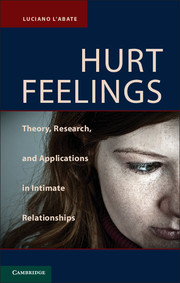Book contents
- Frontmatter
- Contents
- Preface
- Acknowledgments
- Introduction
- Part One Background
- 2 Hurts
- 3 The Origins of Hurt Feelings
- 4 The Developmental Socialization of Hurt Feelings
- 5 Hurt Feelings in the Family
- Part Two The Scientific Bases of Hurt Feelings
- Part Three Applications of Hurt Feelings in Mental Health
- Part Four Models of Hurt Feelings In Theory and Applications
- Appendix A An Informed Consent Form to Deal with Hurt Feelings
- Appendix B Experimental Scale of Unexpressed Hurt Feelings
- References
- Author Index
- Subject Index
3 - The Origins of Hurt Feelings
from Part One - Background
Published online by Cambridge University Press: 05 June 2012
- Frontmatter
- Contents
- Preface
- Acknowledgments
- Introduction
- Part One Background
- 2 Hurts
- 3 The Origins of Hurt Feelings
- 4 The Developmental Socialization of Hurt Feelings
- 5 Hurt Feelings in the Family
- Part Two The Scientific Bases of Hurt Feelings
- Part Three Applications of Hurt Feelings in Mental Health
- Part Four Models of Hurt Feelings In Theory and Applications
- Appendix A An Informed Consent Form to Deal with Hurt Feelings
- Appendix B Experimental Scale of Unexpressed Hurt Feelings
- References
- Author Index
- Subject Index
Summary
Pleasure is always contingent on change and disappears with continuous satisfaction. Pain may persist under persisting adverse conditions. Fridja (2007, p. 13)
Humans show an innate preference for positive affect over negative. Ellgring & Smith (1998, p. 323)
All individuals, if they live enough years, experience the loss of a significant person…. The family’s loss history provides a template for their present grieving and mourning. Weiss (2000, p. 6)
The purpose of this chapter is to consider the emergence and transformation of feelings in general and of hurt feelings in particular as subjectively experienced affects processed and transformed into observably expressed emotions according to salience theory (Fuller, 1967; Kagan, 2007; Rumbaugh & Washburn, 2003) and hierarchical RCT (Cusinato & L’Abate, in press; L’Abate, 2005, 2006, 2008, 2009a; L’Abate et al., 2010; L’Abate & Cusinato, 2007). More specifically, here I will consider hurt feelings in a manner that parallels Rumbaugh and Washburn’s (2003) treatment of emergent responses and emergent problem-solving generated by processes initiated by salient events. Rumbaugh and Washburn (2003) have shown how in primates new, unexpected, and creative behaviors not previously thought of, taught, or even learned arise and emerge into newly creative behaviors without conditioning or reinforcement. Panksepp (2008), by the same token, has shown how animals, including rats, do indeed have affective feelings that can be elicited as they are elicited in human beings. L’Abate (2005) stressed the importance of emotionality from the very outset of RCT, as shown in Chapter 13 of this volume.
These emergent affective feelings are salient and lie dormant in the organism until or unless favorable proximal and distal contextual factors allow or encourage their emergence. Rumbaugh and Washburn (2003) focused their efforts and research on intelligent problem-solving and other cognitive functions, but did not focus as yet on the role of affective feelings in their emergence as emotions. Affective feelings, therefore, can be conceived as internally salient, passively receptive, subjectively experienced, psycho-physiological emergents elicited when specific internal or external conditions or stimuli arise. These feelings are transformed into expressed emotions once words are added or available to name such feelings (Barrett et al., 2007; Buchanan, 2007; Coan & Allen, 2007; Frijda, 2009; Lewis, 2008; Mascolo & Griffin, 1998; Panksepp, 2008; Saarni, 1999).
- Type
- Chapter
- Information
- Hurt FeelingsTheory, Research, and Applications in Intimate Relationships, pp. 77 - 91Publisher: Cambridge University PressPrint publication year: 2011



